How to Prepare Restaurant Quality Veal Stock
It’s time to learn one of the fundamental skills in culinary school: the technique and end-product upon which almost every aspect of French cuisine rests: stock.
The French chefs were experts in procuring every bit of flavor from the leftover bones of the pigs, cows, and chickens they used to create incredible meals. No bones were tossed but used for making classic French stocks in sauces, soups, and stews.
The stock has gained quite a lot of mystique over the years. Many people are under the impression that stocks are difficult to make.
This is not the case. Yes, they are time-consuming, but only for the stove. Many stocks are born in the wee hours of the night: the last cook out the door ensures that the liquid is at a perfect, very slow simmer, and then the stock is left to itself until the next day.
A stock is based on bones. A broth (bouillon, in French) is based on meat. While a broth can be very flavorful, a stock delivers a rich mouthfeel courtesy of the gelatin slowly extracted from the bones.
Along with the depth of flavor, gelatin extraction is the goal of stock making. Rule number one: don’t rush it.
For veal stock, take the time to brown the bones and roast the vegetables. Bring the temperature up slowly; never let it boil; skim diligently, and you will be rewarded with a beautiful stock.
Culinary students get a lot of training in making veal stock since the milder flavor of veal marries with a wider variety of foods, but it is much easier for a home cook to find beef bones, so you may want to try your hand at beef stock. The ingredient list and procedure are identical, regardless.
Culinary students use this stock as the base of mother sauces. It might be the beginning of demi-glace. But how do we, as home cooks, use veal stock? Use this rich stock as a base for French Onion Soup. Use it in vegetable or beef-based soup, chili, stew, etc.
Making your own veal stock for soup might seem like growing your own wheat to make bread, but the depth of flavor afforded by using a homemade stock must be considered. You will be able to tell the difference.
And while, for daily cooking, you can probably get away with using low sodium canned veal broth, do yourself a favor and treat yourself to making homemade stock. We live in a fast-paced world, and making stock allows you to slow down and connect with food on a level we don’t often have time for.
Brown Veal Stock
Ingredients
- 7 pounds veal bones cut into 2 or 3-inch pieces
- 1 can tomato paste
- 1 cup celery chopped
- 1 cup carrot chopped
- 2 cups onion chopped
- 1 cup red wine for deglazing (substitute water)
- 1 tablespoon peppercorns
- 4 bay leaves
- 3 sprigs thyme
- cold water
Instructions
- Preheat oven to 425° F.
- Spread bones in a roasting pan and roast for about 30 minutes, turning once.
- Remove from the oven, and paint a thin layer of tomato paste over the bones.
- Put the vegetables on top of the bones and roast for 15-20 minutes until the vegetables caramelize.
- Remove the bones and vegetables to a stock pot.
- Deglaze the roasting pan with wine or water and pour this into the stock pot.
- Add peppercorns, bay leaves, and thyme. Cover the bones with cold water.
- Over medium heat, slowly bring the bones up to a very gentle simmer. Don’t let the stock boil.
- Adjust the temperature to maintain a gentle bubbling. Every thirty minutes, skim off any foam that rises to the top of the pot.
- Let the stock simmer gently for at least four hours. It can simmer for up to 12 hours if you have the time. Add more water and lower the heat if you get too much evaporation.
- When the stock is done, remove the bones and discard them. Strain through a very fine mesh strainer or a colander lined with three or four layers of cheesecloth.
- Chill quickly, then refrigerate. Skim off the fat that has solidified on top, and discard.

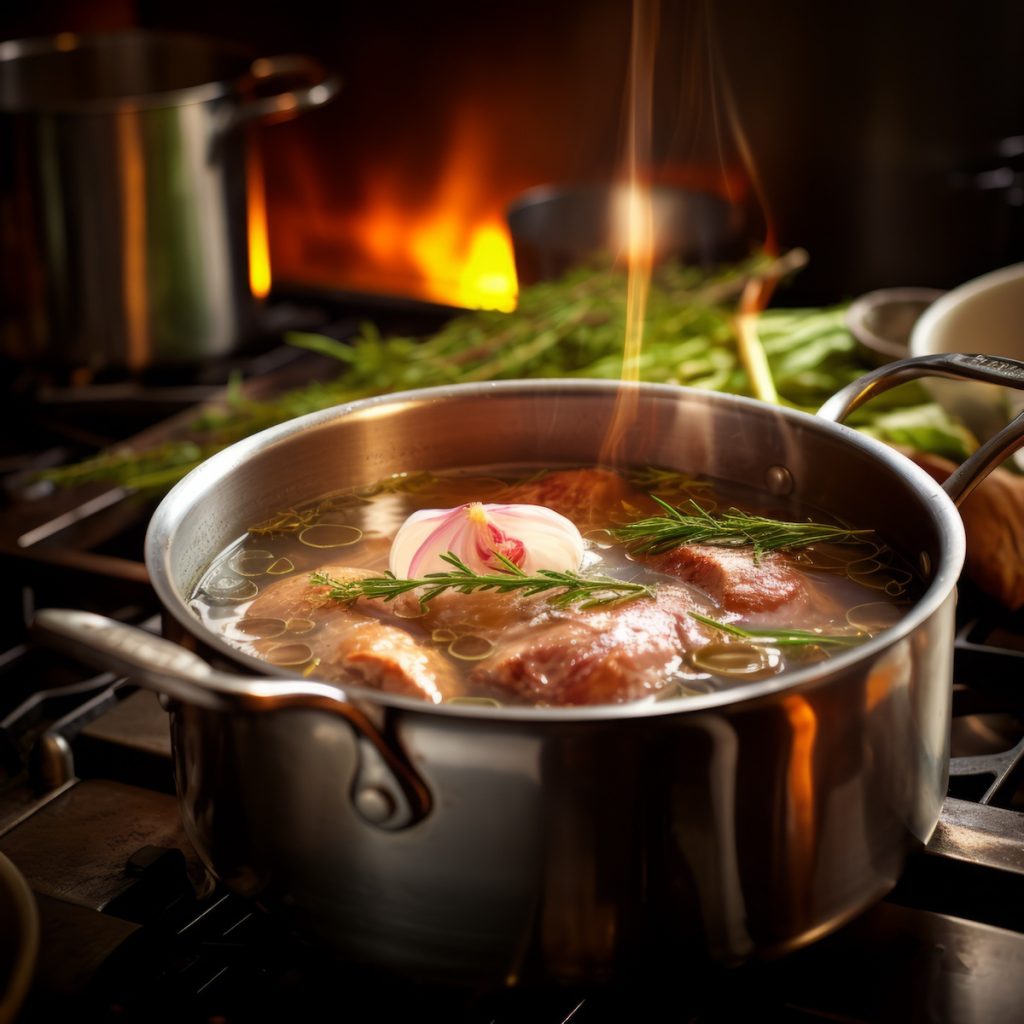

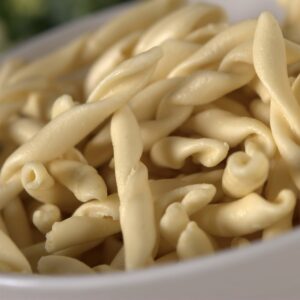


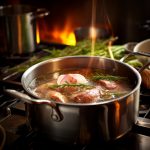
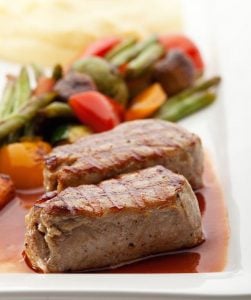



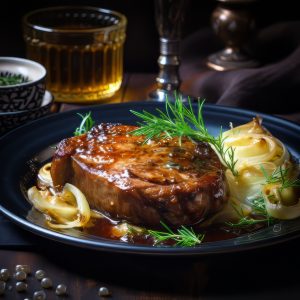
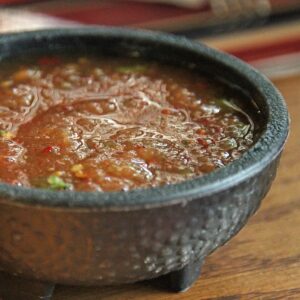
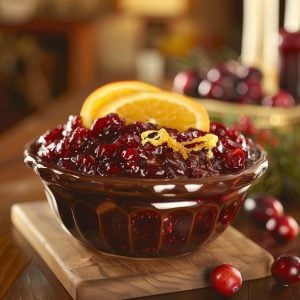



18 Responses
Do you cover the pot with a lid during simmering?
It doesn’t really matter but i never cover stock because it is easier to control the heat uncovered. Gelatin extraction is optimum between 195 and 200 Fahrenheit. you don’t want to go much higher because the fat will emulsify with the water and your stock will become cloudy. Also, if you’re making demi glace, you’re going to reduce it anyways so you might as well make the stock uncovered to begin reduction.
I absolutely love this recipe! It’s sooooo fabulous and scrum-didily-umptious!
If you are not using it straightaway how can it be stored? Does freezing affect the flavour? How long will it last if just refrigerated?
Thanks!
Hi Naz, I freeze all my homemade stocks if I’m not going to use them in 3 or 4 days. I have not noticed any big flavor differences from freezing but I have not done a side by side test.
How much water should I expect to add for 7 pounds of bones?
Good question but I don’t have an answer for you. I don’t make my own stock much anymore because there are some really good commercial products on the market but next time I do, I’ll keep track of how much water is added.
Can you provide a link for any of the good quality commercially available veal stocks. I’ve had a look and all the ones I’ve found are very expensive, I’m reluctant to try one without knowing if it’s good because it would be such a waste.
Hi David, I’ve added some links to Amazon for some fine commercial veal stock. Hope this helps.
5-6 qts of water per 8lbs of bones usually works well
How much broth will this recipe yield?
My rule of thumb is, is just have enough liquid to submerge the bones. Use cold water, and keep adding water as stock reduces.
Hi
According to another site, what this recipe makes is bone broth, not stock. It says you need to then take another step simmering beef meat in it to get to stock. I have no idea who is right and am confused. Which is which and why?
Hi Zoe, this is stock not bone broth. Bone broth is a relatively new word created by probably the food industry to market a new (old) product. Bone broth is one of the latest “hot” foods out their for it’s health value. I am not a nutritionist so I can’t comment on the health benefits associated with bone broth, but I did receive a container from my wife for my birthday this year. Hmmm? For me, it has always been the question between stock and broth. Stock, like the recipe here, is made from mostly bones and vegetables. Broth is made from meat, maybe some bones and vegetables. If you simmer chicken meat without bones with some vegetables, you have broth but you wouldn’t use that to make a sauce because there isn’t a lot of flavor. With stock, you are using mostly bones, some vegetables and maybe some meat trimmings. I’ll have to do some more research on “bone broth” and how it is made, but I can tell you, it is making everything much more confusing to home cooks by calling it “bone broth”.
This recipe was worth every ounce of effort, it was fantastic! I only had about 4 pounds of veal bones, however followed the rest of the recipe quantities (carrots, celery, etc.). The recipe was unclear about the quantity of water, so I filled the pot to cover contents and placed everything on the stove at a medium low temperature on a gas stove to achieve a low rolling simmer/boil, skimming every 30 minutes for about 5 hours. Put it in the refrigerator overnight and then put on the stove again the next day for about an hour, filling the pot to full again and did the slow simmer again.
I didn’t have a cheese cloth, so I used a strainer and got about 12 cups of broth heaven- no store bought anything compares!
Thanks for letting me know and you were correct about adding the water to cover contents. Thanks for reaching out.
Hello,your recipe calls for me to chill quickly, do I refrigerate hot. I have heard should be room temp first. Could you elaborate. Thanks for your time and recipe.
Good question Ian. I agree with you that you should not add hot ingredients to the refrigerator to prevent warming up the fridge. So when a recipe calls for chilling quickly, there are other methods you can use. If you live in a cold weather climate and it is cold outside, you can always place them outside or in the garage. If you live in a warm weather climate, you can give the stock a cold water bath buy filling a larger pot with ice water and place the stock pot into the cold water bath. If you don’t have a pot big enough, you can add cold water to the sink and add some ice and use that to chill the stock. You can also transfer to storage containers and place them in a cold water bath. Hope this helps.